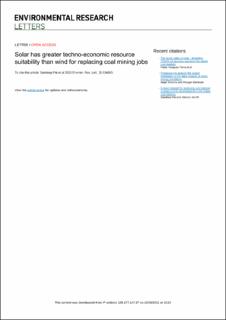| dc.contributor.author | Pai, Sandeep | |
| dc.contributor.author | Zerriffi, Hisham | |
| dc.contributor.author | Jewell, Jessica | |
| dc.contributor.author | Pathak, Jaivik | |
| dc.date.accessioned | 2021-07-28T07:08:40Z | |
| dc.date.available | 2021-07-28T07:08:40Z | |
| dc.date.created | 2020-10-13T22:41:53Z | |
| dc.date.issued | 2020-03-06 | |
| dc.identifier.issn | 1748-9326 | |
| dc.identifier.uri | https://hdl.handle.net/11250/2765429 | |
| dc.description.abstract | Coal mining directly employs over 7 million workers and benefits millions more through indirect jobs. However, to meet the 1.5 °C global climate target, coal's share in global energy supply should decline between 73% and 97% by 2050. But what will happen to coal miners as coal jobs disappear ?Answering this question is necessary to ensure a just transition and to ensure that politically powerful coal mining interests do not impede energy transitions. Some suggest that coal miners can transition to renewable jobs. However, prior research has not investigated the potential for renewable jobs to replace 'local' coal mining jobs. Historic analyses of coal industry declines show that coal miners do not migrate when they lose their jobs. By focusing on China, India, the US, and Australia, which represent 70% of global coal production, we investigate: (1) the local solar and wind capacity required in each coal mining area to enable all coal miners to transition to solar/wind jobs; (2) whether there are suitable solar and wind power resources in coal mining areas in order to install solar/wind plants and create those jobs; and (3) the scale of renewables deployment required to transition coal miners in areas suitable for solar/wind power. We find that with the exception of the US, several GWs of solar or wind capacity would be required in each coal mining area to transition all coal miners to solar/wind jobs. Moreover, while solar has more resource suitability than wind in coal mining areas, these resources are not available everywhere. In China, the country with the largest coal mining workforce, only 29% of coal mining areas are suitable for solar power. In all four countries, less than 7% of coal mining areas have suitable wind resources. Further, countries would have to scale-up their current solar capacity significantly to transition coal miners who work in areas suitable for solar development. | en_US |
| dc.language.iso | eng | en_US |
| dc.publisher | IOP Publishing | en_US |
| dc.rights | Navngivelse 4.0 Internasjonal | * |
| dc.rights.uri | http://creativecommons.org/licenses/by/4.0/deed.no | * |
| dc.title | Solar has greater techno-economic resource suitability than wind for replacing coal mining jobs | en_US |
| dc.type | Journal article | en_US |
| dc.type | Peer reviewed | en_US |
| dc.description.version | publishedVersion | en_US |
| dc.rights.holder | Copyright 2020 The Author(s) | en_US |
| dc.source.articlenumber | 034065 | en_US |
| cristin.ispublished | true | |
| cristin.fulltext | original | |
| cristin.qualitycode | 2 | |
| dc.identifier.doi | https://doi.org/10.1088/1748-9326/ab6c6d | |
| dc.identifier.cristin | 1839347 | |
| dc.source.journal | Environmental Research Letters | en_US |
| dc.relation.project | Norges forskningsråd: 267528 | en_US |
| dc.identifier.citation | Environmental Research Letters. 2020, 15 (3), 034065 | en_US |
| dc.source.volume | 15 | en_US |
| dc.source.issue | 3 | en_US |

